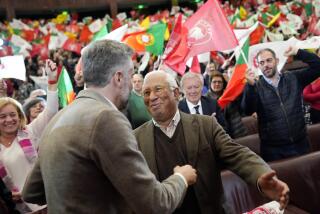Poor Islanders Look to Europe to Assist in Modernization : Azores Hope to Catch Wave of Prosperity
- Share via
LAJES DO PICO, Azores — Silt has built up in the harbor where whaling fleets once anchored. On shore, factories stand derelict. Only a few tourists sip coffee at the Moby Dick Cafe or wander around in the whaling museum.
Since the international whaling ban in 1983, things have been looking bleak for Lajes do Pico and almost all the 250,000 people living in the Azores, the Atlantic archipelago about 740 miles west of mainland Portugal.
But as a Portuguese possession, the Azores now are part of the European Economic Community, headquartered in far-off Brussels, and that has rekindled hopes for modernization and a return of some of the prosperity of old.
Even so, Azoreans are in a struggle.
Among Europe’s Poorest
With a per capita gross national product of $1,286 in 1985, they rank among the poorest people in Europe, trailing Portugal, with $2,160, and Greece, with $3,280. About 28% of islanders work the land.
“All through history, we’ve concentrated on one product--wheat, then oranges, now dairy products. And that’s left us very open to crisis,” said Carlos Cordeiro, history lecturer at the Azores University on Sao Miguel, the largest of the nine Azores islands.
Portugal’s entry into the EEC in 1986 brought a new source of money. According to government figures, EEC funds will increase from $41 million in the previous three-year period to $511 million, or a quarter of the Azorean budget, for 1989-1992.
The U.S. Air Force base at Lajes on Terceira, the island in the middle, was once a source of vital income for the islands and provided jobs for about 1,500 Azoreans.
But revenue from the U.S.-Portuguese base agreement is becoming less significant as EEC assistance rises.
Tourism, Farming Priorities
And Regional President Joao Bosco Mota Amaral has set his priorities: modernize agriculture and fisheries and promote tourism.
Across the water from Pico, the capital of Faial island, Horta, is already booming. Boat crews record their visits with graffiti on the docks, and private yachtsmen pack Pete’s Bar, ordering drinks in French, English, German and Spanish.
Maria da Graca Sousa, director of two luxury hotels on Faial and Pico, said the Azores will offer 3,000 beds by next year but cannot rely on tourism alone.
“The destiny of the Azores in tourism is not cheap,” she said. “It costs a lot to get here and it’s a very specific market--nature, walking and water sports.”
Profitable alternatives are hard to find, however.
‘Sectors in Crisis’
“Nearly all our main sectors are in crisis. Meat and milk are products already in surplus in the EEC,” said Mario Fortuna, a leading Azorean economist.
After more than a year of negotiations, EEC officials recently authorized the islands to set up a duty-free manufacturing zone on Santa Maria, the easternmost of the Azores.
Under the plan, companies can operate tax-free through the year 2011, and the government plans incentives for potential shareholders.
“We’re hoping to attract manufacturers--electronics, pharmaceuticals, plastics--all light and cheap to transport,” said Fortuna, who is chairman of the free-zone administration board.
“It was difficult to persuade the EEC to make an exception just when it’s trying to standardize countries for 1992,” he said. “But if (the Azores) had to use the same rules as regions in the heart of Europe, that would be unfair competition--exactly what the EEC’s against.”
Costly Transport
The high cost of transporting goods and supplies to the Azores is a chief problem, and island shopkeepers charge about 15% more for wares than stores on the European mainland.
The Portuguese government in Lisbon plans to move about 140 air traffic controllers responsible for mid-Atlantic operations from Santa Maria Island to the mainland by 1990. That will mean a loss of purchasing power on the island of 5,000 people and turn its main community, Vilo do Porto, into another Lajes do Pico.
“Many shopkeepers here say they’ll close their doors when the controllers leave. They’re not optimistic that foreigners will want to come and set up business here,” said Luis Pereira of the commercial radio station in Vilo do Porto.
Because of their isolation, Azoreans are superstitious and religious on one hand and open to travel, adventure and foreign ideas on the other. The latter is a main theme of the novel “O Barco e O Sonho” (“The Boat and the Dream”) by the Azorean writer Manuel Ferreira.
Recently turned into a popular Portuguese television series, the novel tells of two Azoreans who build a tiny sailboat to cross the Atlantic in search of a new life.
They see the America of the 1950s as “a marvelous world over the sea . . . its flag--a shower of stars and dollars.”
Emigration has always been a safety valve against poverty, famine and unemployment on the Azores.
Between 1960 and 1980, about 160,000 Azoreans emigrated, mainly for the United States and Canada. Today emigrants and their descendants in North America number about a million--four times as many as live on the islands.
More to Read
Sign up for Essential California
The most important California stories and recommendations in your inbox every morning.
You may occasionally receive promotional content from the Los Angeles Times.










